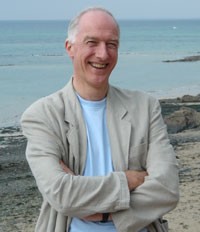The New Optimists
Written by Dr Keith Richards, Centre for Applied Linguistics
Published November 2010
 In a recent edition of Times Higher Education, Jorge Cham included the following in a tongue-in-cheek guide to ‘deciphering academese’:
In a recent edition of Times Higher Education, Jorge Cham included the following in a tongue-in-cheek guide to ‘deciphering academese’:
- "Results were found by direct experimentation."
(Or, "We played around with it until it worked.") - "The data agreed quite well with the predicted model."
(Or, "If you turn the page upside down and squint, it doesn't look too different.")
Humour, though, is sometimes rendered poignant by force of circumstances: a false claim in an IPCC report on climate change and a few hacked emails from climate scientists at the University of East Anglia have stripped these light-hearted observations of their innocence. When Spin meets Science nothing is to be trusted.
It seems an odd time, then, to be introducing a book on science and optimism – better to hunker down well below the parapet. But there are shifts in mood, attitude and policy that are drawing science into new alignments which may have profound consequences for all of us, and in the public arena the sound of something different and altogether more worrying: a disturbing categorisation of science and religion as alternative belief systems. This first surfaced in the protests of creationists but is currently most strident in the climate debate, where words like religion, agnostic and believer are bandied about. If we are not to be misled by such talk, there has never been a more important time to listen to the voice of science and the ideal that it represents.
As the contributions in this collection demonstrate, scientists have different views about issues related to global warming, as they have different views of most things. But what they all agree on, what they are committed to, is doing science. For them, it’s not a question of whether or not they happen to believe in their findings – it’s whether they got the science right.
That’s not how most people see science. Science, as any daily newspaper will tell you, is about discoveries, facts, finding the truth and changing the world. For professional scientists, living down the wilful distortions and extravagant promises made on their behalf by the popular press is an occupational necessity, but seeing science downgraded to just another belief system is harder to swallow. Scientists, like the rest of us, have plenty of beliefs, but the pursuit of science does not allow the luxury of indulging them at the expense of proper procedure.
Science is a way of trying to understand and explain the way things work. It is driven by endless curiosity coupled with a determination not to be beguiled by easy answers. Two examples will illustrate what this means, the first an embarrassing admission of my own failure to live up to these ideals in the preparation of this collection. When editing Mark Pallen’s paper, I came across his quotation from the Gerald Manley Hopkins poem, ‘Pied Beauty’, referring to a ‘brinded cow’. I thought this was a typo because I remembered it as ‘brindled cow’, so I decided to check.
On a good day you might call me a social scientist (at least that Faculty has yet to disown me), but this wasn’t a good day, so instead of looking for falsification as any decent scientist would, I took the self-indulgent route and opted for verification. Into Google went ‘brindled cow Hopkins’, and because I looked for it I found it: out came pages and pages of confirmation, headed by a Wikipedia entry. I edited the text accordingly and moved on.
This is the sort of mistake that has been described as a Type 1 error, a false positive. Sloppy procedure. Mark was quickly back to me, gently pointing out that the original uses ‘brinded’. Back in the Wikipedia entry I find my original quote, ‘For skies of couple color as a brindled cow’ and notice for the first time the spelling of ‘color’. Then, taking the trouble to read on, I discover the following just five lines further down: ‘he compares “skies of couple-colour” to a “brinded cow”’. Having first given my toes time to uncurl, I check this in an Oxford edition, make the necessary change, apologise and move on. No harm done – but then I’m not squaring up to the challenges of cancer or ageing.
My second example is simpler and infinitely more inspiring. In his entertaining contribution, David Jones explains how his work on muscle fatigue followed a particular line of enquiry for 30 years, but ‘always with a slight nagging doubt’. Then a series experiments revealed to him that he and his colleagues had been fundamentally wrong for all that time. Writing off 30 years of work would plunge most mortals into deep denial or drive them into the arms of a convenient therapist, but David is a scientist – he became very excited!
Science does funny things to people. It fills them with an insatiable desire to understand while denying them easy answers, it tempts them with the infinite possibilities while shackling them with unbending rules of procedure – and it denies them rest. Discovery in science is never the end, always a beginning, a new set of questions and possibilities. That’s why David was excited and why the treasures in this collection are to be found not just in the wonderful discoveries and insights these scientists share with us but in the prospects they open up. This is optimism with a purpose.
Of course, the richness of such a collection offers both delight and illumination in itself, as is evident from the following questions:
- What’s the connection between lobsters and leukaemia?
- Which child’s toy was used in the development of the first contact lens?
- How many litres of water does it take to produce (a) a litre of milk and (b) a kilogram of beef? (Add a nought to each of the figures you’ve just come up with.)
- How many people have become infected with TB in the last minute?
- If you wanted to avoid injury would you choose to be a racing driver, a footballer, a ballet dancer or a builder?
- Which country was primarily responsible for the eradication of smallpox?
The answers to all of these are to be found in the contributions that follow, but even more interesting are the questions waiting to be answered. Derek Alderson tells us in his contribution that over the last forty years the incidence of oesophageal adenocarcinoma has risen from just one tenth to three-quarters of all oesophageal cancers in the UK and that the UK has the highest incidence of this form of cancer in the world, but as yet we don’t know why. The writers in this collection convey the excitement, and sometimes the urgency, of confronting questions such as these. Theirs is an optimism grounded in engagements of this kind – and it is all the more inspiring for that.
Contributors, whose work embraces both natural and social sciences, were asked to draw on their own research in responding to a very simple question previously posed by John Brockman: What are you optimistic about? The result is a rich and varied collection which gives voice to a range of views and opinions in a variety of styles.
The organisation of such diverse material must inevitably be a personal matter, but we wished to take the reader on a journey in four stages, beginning in familiar surroundings looking in on the work of scientists, then moving gradually towards their world until finally we are inside looking out. We therefore divided the collection into four parts, each comprising chapters related to the same broad theme, and within each chapter we gathered the contributions themselves:
- Part 1: The Microcosm: Tackling the big challenges
Cancer and Changing bodies - Part 2: The Macrocosm: Interacting with our world
Living in the natural world and Living in the virtual world - Part 3: Transformations
Getting to the heart of things and Changing behaviour - Part 4: The ways of science
Working together, Thinking differently and From where I stand
Next week, the Knowledge Centre will be bringing you an essay from one of Warwick's contributors to The New Optimists.
The New Optimists is published by Linus Publishing Company.
 Dr Richard's background is in English teaching, first in the state system in England and then in Europe and the Middle East. After a period as an ESP consultant, he completed an MSc at Aston University and stayed on to develop a distance learning Master's programme in Teaching English for Specific Purposes. He remained at Aston as Director of the Language Studies Unit for nearly 20 years. Dr Richards moved to Warwick in 2004, becoming the Director of Graduate Studies at the Centre for Applied Linguistics. His main research interests lie in the area of professional interaction, with a particular focus on aspects of collaborative talk, argument and the discursive construction of identity. Dr Richards also conducts research in the area of qualitative research methodology and has a particular interest in discursive aspects of qualitative research interviews.
Dr Richard's background is in English teaching, first in the state system in England and then in Europe and the Middle East. After a period as an ESP consultant, he completed an MSc at Aston University and stayed on to develop a distance learning Master's programme in Teaching English for Specific Purposes. He remained at Aston as Director of the Language Studies Unit for nearly 20 years. Dr Richards moved to Warwick in 2004, becoming the Director of Graduate Studies at the Centre for Applied Linguistics. His main research interests lie in the area of professional interaction, with a particular focus on aspects of collaborative talk, argument and the discursive construction of identity. Dr Richards also conducts research in the area of qualitative research methodology and has a particular interest in discursive aspects of qualitative research interviews.
